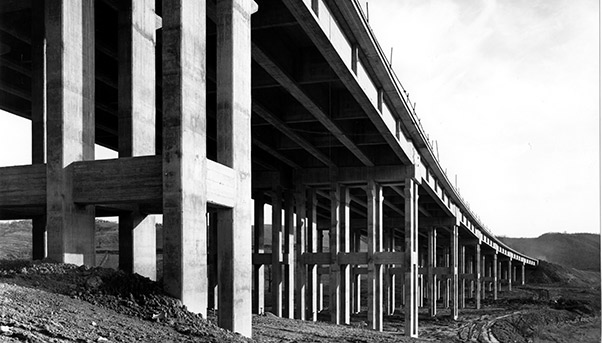
Public works often define an age. As their respective inaugurations recede in time, they become monuments to the ambitions of the people who built them and the dreams of those who used them. Built with skill and foresight, they become a permanent fixture in a country’s landscape. Italy’s Autostrada del Sole, or Highway of the Sun, is one of those works.
Italy’s “Spinal Cord”
Although it was built a half a century ago, the highway, also known as the A1, remains the country’s longest at more than 700 kilometres.
Running the length of the peninsula from Milan to Naples via Bologna and Florence, it was described as the country’s “spinal cord” by Francesco Aimone Jelmoni, a professor of engineering who helped plan it.
After its inauguration in 1964, the highway quickly embodied the optimism of the post-war era. The “dolce vita” was in full swing: Italy was enjoying its Economic Miracle, a boom that was turning it into an industrial powerhouse and elevating millions of its people into the middle class. Just as many bought their first car, the ultimate symbol of emancipation. And since they immediately took to this new highway to discover their country, the Autostrada del Sole also became loaded with meaning.
“The highway was seen as the future,” historian Ernesto Galli della Loggia told a show about Autostrada del Sole once shown on RAI, Italy’s public television broadcaster.
This marvel of mobility contributed greatly to the development of the country’s economy. By uniting the north with the south, it facilitated the movement of goods. Trucks took one day rather than the usual two to travel from one end of the country to the other. This cut down on transportation costs and, consequently, the price of consumer goods, further improving the quality of life of Italians.
Travel also flourished. People not only left their hometowns for the holidays but also for better prospects – notably a job in one of northern Italy’s factories.
Rallying to the Cause
Although Italy had spent years since the end of the Second World War repairing its badly damaged network of roads and bridges, it had yet to embark on a project whose scale would transform the country.
By 1950, the state of this network was only slightly better than it had been after the war: of the 175,000 kilometres roads outside city limits, 150,000 remained unpaved, according to a 2010 article in Strade & Autostrade magazine.
Recognizing the tremendous boost that a national highway could give to the country’s economy, the government rallied everyone to the cause, recruiting not only the country’s best engineers, but also its captains of industry.
The investment that the government was prepared to make exceeded 100 billion lira – a massive amount at the time, making the Autostrada del Sole the country’s biggest infrastructure project since the end of the war.
Soon after being chosen to oversee its construction, engineer Fedele Cova travelled with a team to the United States in 1956 to study how the interstate highway network had been designed and built. What they were to learn during their time overseas would be applied to the construction of the Autostrada del Sole.
Since they had everything to gain from an infrastructure that would encourage the use of the car, Italy’s biggest industrial companies were more than willing to answer the government’s call for help, according to Giuseppe Centolani, a highway designer, in an interview for another RAI show on the history of the highway. So the companies – car maker Fiat, tire maker Pirelli, fuel distributor AGIP and cement maker Italcementi – joined forces to provide a feasibility study and preliminary plan for the construction of the highway.
A1 Motorway: Italy’s “Spinal Cord”

Keen to have as many builders involved as possible, Cova gave everyone a section of the highway through the awarding of hundreds of lots. Three of the myriad recipients were Girola, Lodigiani and Impresit, whose eventual three-way merger would create a predecessor of Salini Impregilo. In the case of Lodigiani, it received four lots. One of them, Lot 7b in Florence, was to have the biggest tunnel, running at 930 metres.
Such was the project’s importance that Italy’s president at the time, Giovanni Gronchi, was later to inaugurate the start of construction by laying the first stone in the southern neighbourhood of San Donato Milanese in May 1956.
During the eight years of its construction, the highway was progressively opened, one section at a time. The first was the 195 kilometres between Milan and Bologna in 1959. After overcoming the most difficult stretch between Bologna and Florence with the deep valleys of the Apennine mountain range, the Autostrada del Sole was completed in October 1964.
Such was the splendor of the finished work that many of the highway’s hundreds of bridges were to become the subject of an exhibit at the Museum of Modern Art (MoMA) in New York, according to “leStrade” magazine in a 2014 article celebrating the 50th anniversary of the project. “’The most beautiful highway in the world’,” it quoted foreign experts as saying at the time.

